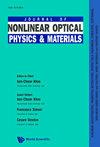Halogenation effect on physicochemical properties of Ti3C2 MXenes
IF 2.3
4区 物理与天体物理
Q2 OPTICS
引用次数: 2
Abstract
Halogenated MXenes have been experimentally demonstrated to be promising two-dimensional materials for a wide range of applicability. However, their physicochemical properties are largely unknown at the atomic level. In this study, we applied density functional theory (DFT) to theoretically investigate the halogenation effects on the structural, electronic, and mechanical characteristics of Ti3C2, which is the most studied MXene material. Three atomic configurations with different adsorption sites for four kinds of halogen terminals (fluorine, chlorine, bromine, and iodine) were considered. Our DFT results reveal that the adsorption site of terminals has a considerable impact on the properties of MXene. This can be ascribed to the different coordination environments of the surface Ti atoms, which change d-orbital splitting configurations of surface Ti atoms and the stabilities of systems. According to the density of states, crystal orbital Hamilton population, and charge analyses, all the considered halogenated MXenes are metallic. The electronic and mechanical properties of the halogenated MXenes are strongly dependent on the electronegativity of the halogen terminal group. The Ti–F bond has more ionic characteristics, which causes Ti3C2F2 mechanically behave in a more ductile manner. Our DFT results, therefore, suggest that the physicochemical properties of MXenes can be tuned for practical applications by selecting specific halogen terminal groups.卤化对ti3c2mxenes理化性质的影响
卤化MXenes已被实验证明是一种有前途的二维材料,具有广泛的适用性。然而,它们在原子水平上的物理化学性质在很大程度上是未知的。在本研究中,我们运用密度泛函理论(DFT)从理论上研究了卤化对MXene材料Ti3C2的结构、电子和力学特性的影响。考虑了四种卤素末端(氟、氯、溴和碘)具有不同吸附位点的三种原子构型。我们的DFT结果表明,终端的吸附位置对MXene的性能有相当大的影响。这可以归因于表面钛原子的不同配位环境,改变了表面钛原子的d轨道分裂构型和体系的稳定性。根据态密度、晶体轨道汉密尔顿居数和电荷分析,所有卤化MXenes都是金属。卤化MXenes的电子和机械性能强烈依赖于卤素端基的电负性。Ti-F键具有更多的离子特性,这使得Ti3C2F2具有更强的延展性。因此,我们的DFT结果表明,可以通过选择特定的卤素末端基团来调整MXenes的物理化学性质,以适应实际应用。
本文章由计算机程序翻译,如有差异,请以英文原文为准。
求助全文
约1分钟内获得全文
求助全文
来源期刊
CiteScore
3.00
自引率
48.10%
发文量
53
审稿时长
3 months
期刊介绍:
This journal is devoted to the rapidly advancing research and development in the field of nonlinear interactions of light with matter. Topics of interest include, but are not limited to, nonlinear optical materials, metamaterials and plasmonics, nano-photonic structures, stimulated scatterings, harmonic generations, wave mixing, real time holography, guided waves and solitons, bistabilities, instabilities and nonlinear dynamics, and their applications in laser and coherent lightwave amplification, guiding, switching, modulation, communication and information processing. Original papers, comprehensive reviews and rapid communications reporting original theories and observations are sought for in these and related areas. This journal will also publish proceedings of important international meetings and workshops. It is intended for graduate students, scientists and researchers in academic, industrial and government research institutions.

 求助内容:
求助内容: 应助结果提醒方式:
应助结果提醒方式:


